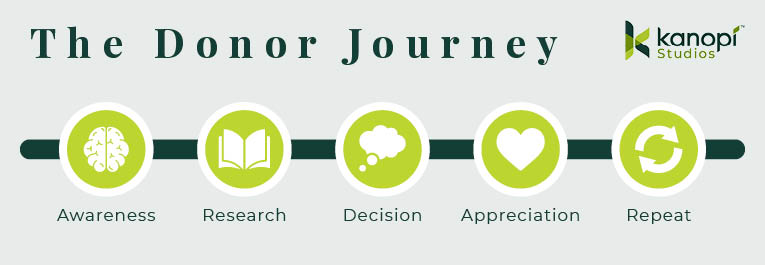Similar to the choices in our everyday lives, the decisions your donors make can impact how and if they decide to give to your organization. This is known as the donor journey.
Regardless of whether you’re a long term fundraising professional or you’ve just established your nonprofit organization, the donor journey shouldn’t be an unfamiliar term. It’s pretty self-explanatory—it describes how a potential prospect makes their way to becoming an official donor and an advocate for your mission.
But why is this important?
Understanding the donor journey will not only help you track how and when your supporters give, but also provide some basis to why they donate. The more familiar you are with your donors’ journeys the better you can engage with them and garner more support down the line.
Table of Contents
- What is the Donor Journey?
- The Elements of the Donor Journey
- How to Map Donor Journeys for Your Nonprofit
What is the Donor Journey?
Your donors are one of your most important assets. They provide you with the essential funding needed to continue your meaningful work and serve your community. It makes sense that you do everything you can to not only recruit donors but also retain them. This is where the donor journey begins.
Whether you’re working with a nonprofit, higher education institution, or other fundraising entity, the donor journey is a key resource that fundraising professionals leverage to better understand their supporters and secure funding for their organization. Each stage of the donor journey clues you in to how you can best engage with prospective donors and successfully receive that gift.
Mapping out a donor journey provides the framework that tracks how and when your supporters give and communicate with you, as well as why they make the giving choices they do. Incorporate this into your nonprofit digital strategy and regular marketing efforts to guide how you interact with your supporters.
This can result in more completed donations or event registrations, and even increase the lifetime contribution of donors.
The Elements of the Donor Journey
What makes up the donor journey? This will differ depending on your organization and your supporters, but it will likely follow these elements regardless of your unique situation: Awareness, research, decision, appreciation, and repetition.

Donor Journey Step 1: Awareness
This is the very step of the donor journey. Whether it’s through your website, a post from a friend on social media, or just word of mouth, this is the moment that the prospect becomes aware of your organization and mission.
Without awareness, the donor journey never begins. How can you raise awareness and increase the chance of new supporters? Here are some tips:
- Invest in optimizing your nonprofit website for SEO.
- Create user personas to better understand the type of audiences discovering your organization.
- Actively use your social media channels to give updates on your mission.
- Update your website with recent accomplishments and major changes, as well as news stories and blog posts related to your mission.
- Keep your content human-centric to appeal to new supporters.
Donor Journey Step 2: Research
Once someone is aware of the need for your mission, they’ll likely do further research to figure out if they want to support the cause and how they can support it.
This entire stage is about building trust. You need to give potential donors a reason to give to your organization and support your efforts.
First off, ensure your nonprofit website is optimized. After all, this is likely the first place a prospect is going to look when researching your cause. Your website should be regularly maintained and updated to hold valuable content on your mission and organization. You can:
- Use success stories and infographics to relay accomplishments and important metrics quickly.
- Show concrete metrics and give data to back up your claims.
- Practice transparency by being honest about where your funds go and by being open to answering questions.
- Compile and share an annual report that summarizes your yearly accomplishments and progress.
- Include testimonials from other donors or from specific community members you help.
While being honest is a priority, try to focus on the value you bring to the community and stay away from “the bad.” Users are less likely to donate to sad stories.
Donor Journey Step 3: Decision
Now that the prospect is familiar with your organization and the work you do, they’ll show their intent in some way. This can be opting into email newsletters or following your social media accounts. They might even finalize their decision and make their first gift.
To encourage prospects to take the leap and donate, consider the following:
- Make your donation forms and page easy to find on your website. A website user’s attention span lies somewhere around eight seconds, so including a link to your donation page within your menu or with a bright button is key.
- Ensure the target action is prominently displayed in all marketing content, including social media and email. Incorporate CTAs like large buttons and easy-to-find links that send prospects to your donation form.
- Make recurring donations a primary option. Within your donation form, add a simple box that your supporters can check off if they want to give regularly. Making recurring donations a primary option encourages your donors to become consistent givers.
- Show the value of suggested donation amounts. Sometimes it can be hard to contextualize how a gift will help an organization. List a couple of suggested amounts as well as the direct impact it has. For example, a $100 gift will pay for 10 meals at a local homeless shelter.
- Design your website with an accessible user experience (UX) in mind. Ensure that your nonprofit website is accessible to all, no matter the location, language, ability, or device. This not only enhances the user experience but opens up your supporter base to more people. Learn more about this topic with our article on demystifying website accessibility compliance.
Donor Journey Step 4: Appreciation
Once the gift is made, this doesn’t mean the journey is over. In fact, this is the perfect opportunity to set the foundation for future engagement with a thank you letter and a summary of impact.
Showing donor appreciation is an integral part of the donor journey. Your supporters must know just how much their contribution has impacted your mission. The reason that many donors stop giving is often that they simply don’t know what their previous gift did.
Here’s what you can do:
- Use your email solution to automate thank you messages to send as soon as a gift is made.
- Take advantage of data automation to personalize each message with name and gift size.
- If known, describe the specific impact the gift has made.
- Include a “next step” in your letter, such as signing up for newsletters or reading about a success story.
- Follow up once the campaign is fully completed and use data metrics to report on the full impact of the gift.
- Add an option so that donors can share their contribution to social media, further spreading awareness of your mission.
Donor Journey Step 5: Repeatable
Ultimately, the final goal of recruiting new donors isn’t the gift itself. It’s the meaningful relationship established and its foundation for long-term support.
With the donor journey, you’ll be going through the same cycle over and over again. (However, that doesn’t mean you have to update your website or marketing materials—but it is a good idea to review them to ensure they are fully up-to-date.)
In order to continue donors on this journey, you’ll have to keep inspiring them with valuable messaging, update your website with the most recent accomplishments, and continue to build these important relationships.
Your relationship should be built on open communication—not a marketing initiative. Make sure to welcome feedback, share successes, alert to upcoming events online or off, and show appreciation at each step.
How to Map Donor Journeys for Your Nonprofit
The donor journey for your own nonprofit will follow the basic elements above. But to understand the specifics, this will require some careful consideration and planning:
- Define your key performance indicator (KPI) metrics. KPIs help you measure organizational success. However, this refers to more than just fundraising dollars. Website visits, email opens, and more can all be helpful KPIs to track. Make sure to also review benchmark data to see how other organizations similar to yours are measuring success.
- Analyze your audience personas and the channels they use to interact with your organization. Many marketing leaders will use audience personas to better understand their supporters and create more targeted content and strategies to reach them. Consider the types of supporters your nonprofit has and the ways they engage with your organization. Do they often check out your website for new updates? Do you interact with them a lot on social media?
- Isolate the aspects of your digital user journeys that apply to the donor journey model. In an increasingly digital world, the way people find out about your mission is primarily going to be online. Keep track of and isolate how your digital users engage with your offerings to help determine if you need a tech upgrade.
- Review the elements of an effective donor journey and make note of any areas you might fall short. Do you find yourself lacking in the amount of researchable content on your website? Do you have a lot of supporter engagement but not an increase in gifts? Making note of these elements will give you a clue on the touchpoints you need to work on.
- Look at your nonprofit database to see if there are any common areas where donors fell off the journey cycle. Similar to above, see if you can pinpoint the donor journey step where prospects typically fall off. This can also give you a clue into what improvements you can make to your recruitment and retention strategies.
- Ensure your donor data is in alignment with your personas, metrics, and organizational goals. This will guide how you map your donor journey and if any elements need tweaking.
- Revisit, refine, and retest often! Don’t just outline your donor journey and stop there. It’s critical that you continue to review and track how your supporters engage with your offerings and whether or not they give. Whether it’s due to new modern solutions or a global pandemic keeping everyone home, the donor journey is sure to change over time.
To accurately flesh out the donor journey and apply its insights to your own organization, turn to a nonprofit technology consultant, like Kanopi.
By working closely with a professional, you gain a better sense of not only how your supporters engage with your organization but also how you can take those findings and use them to improve outreach and retention strategies.
How Kanopi Can Help
We at Kanopi are a top partner for nonprofits, helping to develop over 150 active sites and start their digital transformation.
Our continuous improvement team works closely with your own organization to become fully familiar with your goals and supporter base. With thorough research and key insights into the larger nonprofit and web industry, Kanopi can help you map out a donor journey and:
- Create user personas to determine your nonprofit audience and come up with an outreach strategy that best targets their needs.
- Design your website with the donor journey in mind to ensure it is SEO-optimized and funnels prospects to your online donation page.
- Analyze your content strategy for areas to optimize that journey.
- Offer any insight as to the best ways your website can aid your donor journey.
- Ensure your website is keeping up with accessibility and compliance guidelines.
Partner with us to start leveraging the donor journey for your own organization. We can help ensure your nonprofit marketing methods and website meet your needs and help you with your goals. Contact us here to learn more.









